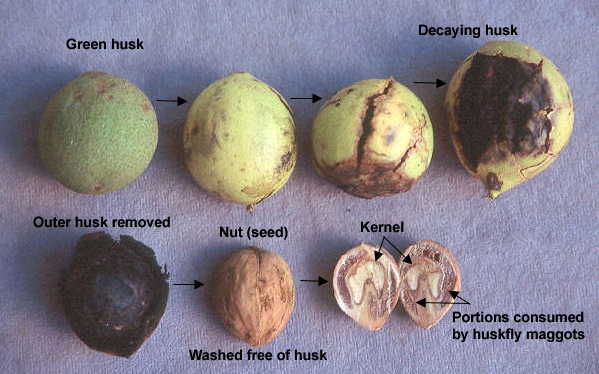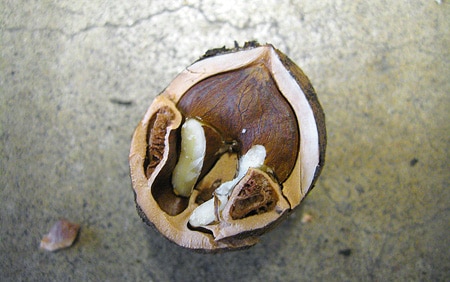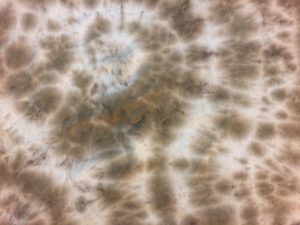Black Walnut (Juglans nigra)
Tree Facts
Black Walnut (Juglans Nigra) is a perennial, stone fruit tree native to Eastern North America, commonly found in riparian zones (area between water and land). Technically the walnut produces a fruit called a “drupe” and is not a true nut! The drupes are harvested in the fall, dehulled and dried to allow the nut meat to cure for consumption. This tree can grow very large, eventually reaching over 100’ in height and 6’ in diameter. The black walnut is a member of the Juglandaceae family. Careful consideration should be made before planting or growing around this tree as it is allelopathic, suppressing growth of many other plant species by releasing a chemical called juglone. The black walnut contains the highest concentration of juglone in the nut hulls, roots, and leaves and is commonly used as an herbicide. This tree has numerous uses, such as: nutritional, medicinal, dye, structural/decorative, antibacterial, and herbicidal.
Seasonal Care-
The black walnut tree grows well between zones 5a-9a. Commonly found natively near water, these trees prefer deep rich soil, moist yet well drained. Black Walnut is self fertile, but puts on a better fruit set with two trees. It is generally easy to grow with little attention needed.
Winter/ Spring: Pruning is generally not necessary. Compost or organic fertilizer can be added in the Spring to maximize nut production.
Summer: The first year, a Black Walnut tree should be irrigated every week with 3-5 gallons of water. Once established, the tree generally only needs watering during severe drought.
Fall: Fruit is generally harvested from the ground, dehulled and allowed to dry for a few weeks before cracking the nut and consuming/storing the nut meat.
Nutritional Benefit:
Black Walnuts are packed with nutrients and are considered a superfood. They contain one of the highest protein contents of any nut (7 grams per serving), as well as high levels of Manganese, Omega-3, antioxidants and other nutrients. The nutritional content supports metabolism and bone structure, and can help protect against cardiovascular disease, diabetes, and certain neurodegenerative conditions.
Propagating Black Walnut Trees:
As previously noted, Black Walnuts are toxic to a variety of plants and research should be done prior to planting to understand the effects that Black Walnut will have in that area. Black Walnuts are best propagated by seed, collecting the fruit in the fall dehulling and immediately placing 5-6 whole nuts, 5-6” in the ground. Protect the nuts from animals, by placing chicken wire or cloth over the nuts and securing to the ground. Cover with leaves/mulch and be sure to properly label location. In the spring remove the protective cover and water the sapling every week with 3-5 gallons of water.
Processing Black Walnuts for Nutmeat
- Pick nuts up off the ground as soon as possible by hand or nut wizard. It is best to process nuts while the hull is mostly green to avoid mold and astringent nutmeat.
- Use gloves to handle and de-hull the nuts. They will stain your fingers. They will also stain concrete for a period of time, clothing, and other surfaces.
- Remember that walnut hulls halve a chemical called “juglone” that suppresses the growth of certain plants, so be mindful of where you take your hulls and wash water
- Remove green hulls with hammer, knife, or strong hands (some people step on them or even drive over them covered in a tarp!). If hulls are too tough to work, let soften for a few days or buy a de-huller!
- If you encounter worms when removing hulls, do not be alarmed as they do not affect the nut meat inside the inner shell
- Rinse de-hulled walnuts to remove debris however you wish. A simple method is to fill a 5-gallon bucket with water and agitate a batch of nuts with a hoe, cement mixer, or by hand three times. Discard nuts that float, a legendary sign of likely spoilage.
- Spread cleaned nuts out in a single layer to dry for 2-4 weeks. Make sure you do this in an area that squirrels absolutely cannot get to, as they will find a way to steal your nuts. Squirrels broke into Michael’s outdoor solar dehydrator this year because the openings didn’t have thick enough wire mesh! Some people swear that forced heat drying black walnuts at 95-100 deg F for 3-4 days is best for flavor and storage. Turn the shells every so often throughout the drying process.
- Dried nuts can be stored in shell in a cool, dry location. They can be also be frozen until ready for use. Shelled nuts can be stored in a fridge or freezer for longer shelf life, and salt brining with further dehydration is a way to store walnuts longer at room temperature.
- To crack black walnuts, do not use a regular nut cracker. It will break. Use a nut cracker that is made for black walnuts, or use a vice grip, or hammer with good hand eye coordination. You’ll want a nut pick or small scraping device to remove the nut meat from the cracked shell.
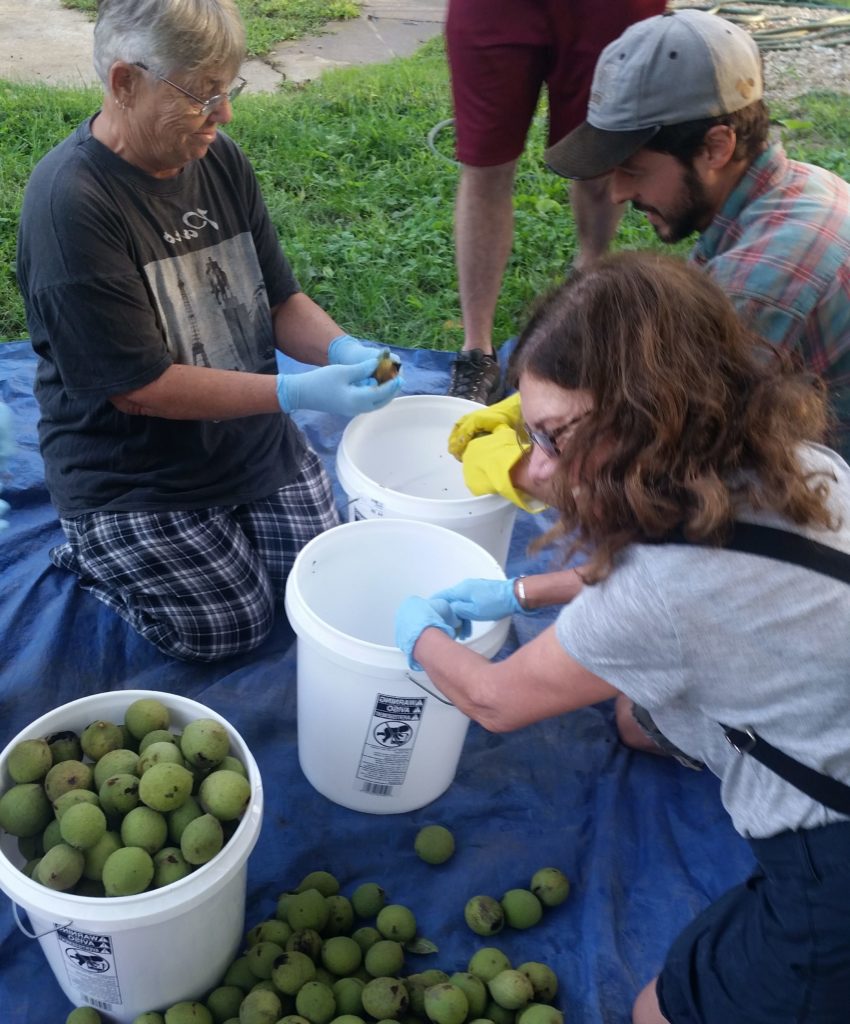
Black Walnut Recipes!
- Basic Black Walnut Pie
- Black Walnut Hummingbird Cake (Cream Cheese Frosting)
- Black Walnut Cinnamon Ice Cream
- Black Walnut Fudge
- Black Walnut Chicken Quiche
**Click HERE for more delicious black walnut recipes!!**
Processing Black Walnuts for Dye, Wood Stain, and Ink
- Add green hulls to a stainless steel pot of water (We used the first rinse water from the above process).
- Simmer for at least 30 minutes. For darker colors simmer longer, add more hulls, and even boil down the liquid.
- Cool the liquid and strain through muslin bag or other cloth.
- Test the strength of the dye/stain/ink. If darker color desired, return to step 2. Be careful not to scorch the liquid if boiling it down.
- Store liquid in a glass jar or bottle, and add 100 proof vodka or rubbing alcohol (up to 1:4 ratio) to prevent mold and preserve for later use. The liquid will mold after a while if untreated.
- Experiment with tie-dye or other fabric dying methods, black walnut as a wood stain, and as ink! Fabrics dye a cocoa brown and do not require a pre-mordant for dye to set as with other dyes. Wood stain is a light brown that can me made darker by concentrating the liquid.
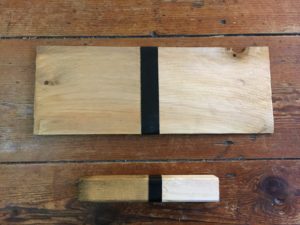
Black Walnuts as Medicine
Black walnut hulls contain very powerful medicine that has been used for a variety of conditions including intestinal worms in humans and animals, while it must also be approached with caution. It is also a natural source of iodine. Do not attempt to use black walnut medicine without first consulting professional medical practitioners and clinical herbalists.
This POP Blog was written by 2018 POP Intern Greg Hample and Orchard Director Michael Muehlbauer with assistance from Admin Assistant Natalie Agoos.
SUPPORT US! If you found this entry useful, informative, or inspiring, please consider a donation of any size to help POP in planting and supporting community orchards in Philadelphia: phillyorchards.org/donate.
Links for more info:
https://www.instructables.com/id/Forage-and-process-your-own-black-walnuts/
https://www.instructables.com/id/Black-Walnut-Harvesting-Processing/
https://www.meetup.com/Wild-Foodies-of-Philly/
https://www.acepaintsfurniture.com/can-make-homemade-stain-using-walnuts/

